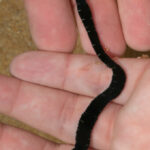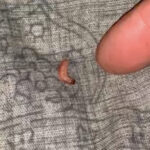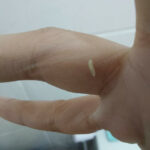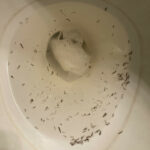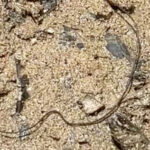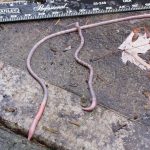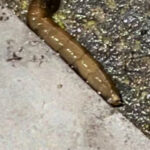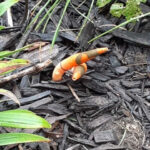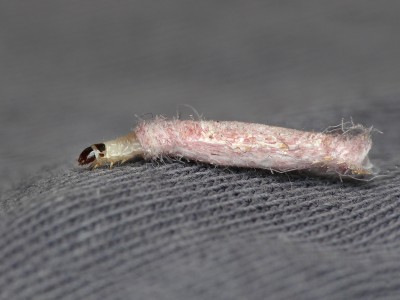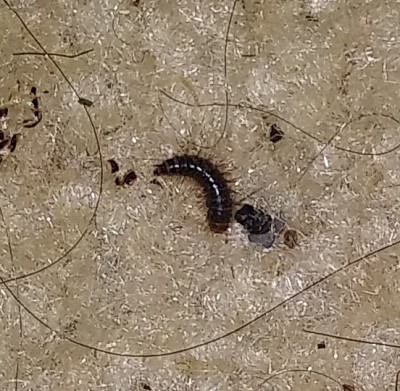
We recently heard from a reader who discovered some dark brown “worms” around her home. She found some in a drawer where she stores grass-like placemats, and about 10-15 more of the specimens under a small throw rug in her kitchen where she feeds her cats their food and water. She explained that her apartment has wall-to-wall carpeting in every room except from the bathroom and the kitchen. Our reader is curious about what these creatures are and where they are coming from. This is the photograph she included:
The specimen is small and dark brown. It has a segmented body that is covered in tiny bristle-like hairs. The information our reader provided and this photo confirm what we suspected. The worm-like organisms our reader has been finding are carpet beetle larvae.
Carpet beetle larvae are among the most notorious specimens here at All About Worms. They can be extremley annoying houseguests for a few reasons. They feed on a wide variety of items found around a home so eliminating their food sources can be tedious. Also, they can survive for long periods of time without food and can travel from room to room looking for additional food sources if they run out. Finally, their feeding habits can be quite destructive. Since our reader found carpet beetle larvae in multiple locations in her home, we think she might be dealing with a small infestation. In order to get rid of these larvae she will need to begin an intense cleaning regime as soon as possible.
As we mentioned, carpet beetle larvae have a lot of potential food sources. They eat animal products such as wool, felt, feathers, leather, and fur. They also eat fabrics, linens, upholstered furniture, carpeting, pet hair, and other small particles found around a home. To get rid of these creatures our reader will need to remove all of the main food sources attracting these carpet beetle larvae. She should start by removing the grass placemats and the rug in her kitchen. Both items should either be professionally cleaned or disposed of since they might be hiding eggs. Our reader will need to keep an eye out for other food sources and remove them as well. Once she has gotten rid of the primary food sources, she should begin a cleaning regime to remove any other unseen larvae, eggs, and other potential food sources. This should include vacuuming, dusting, sweeping, and doing laundry every day. Since she mentioned she has cats, she should also be sure to wash all of the cats’ bedding and toys, since carpet beetle larvae eat pet hair and dander. Although it can be exhausting to focus so much energy into cleaning, it is the most effective way to get rid of carpet beetle larvae.
To sum up, one of our readers discovered carpet beetle larvae in a few places in her apartment. We are afraid she might be dealing with a small infestation. As we have explained, the only way to get rid of carpet beetle larvae is to maintain a vigorous cleaning regime. If our reader feels that this regime is too much to handle, she can reach out to a professional to help with the infestation.
All About Worms is always free, always reader-supported. Your tips via CashApp, Venmo, or Paypal are appreciated! Receipts will come from ISIPP Publishing.
You might also find these guys interesting!





